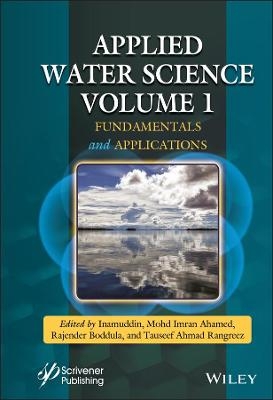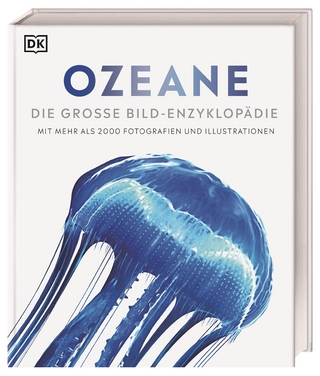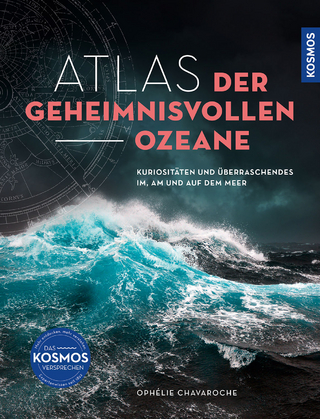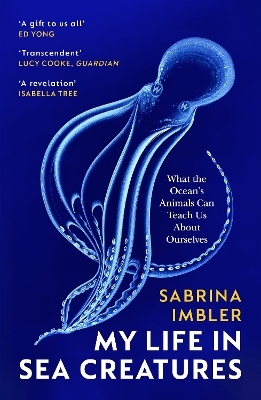
Applied Water Science, Volume 1
Wiley-Scrivener (Verlag)
978-1-119-72476-6 (ISBN)
This book explores the basic concepts and applications of water science. It provides an in-depth look at water pollutants’ classification, water recycling, qualitative and quantitative analysis, and efficient wastewater treatment methodologies. It also provides occurrence, human health risk assessment, strategies for removal of radionuclides and pharmaceuticals in aquatic systems. The book chapters are written by leading researchers throughout the world. This book is an invaluable guide to students, professors, scientists and R&D industrial specialists working in the field of environmental science, geoscience, water science, physics and chemistry.
Inamuddin, PhD, is an assistant professor at the Department of Applied Chemistry, Zakir Husain College of Engineering and Technology, Faculty of Engineering and Technology, Aligarh Muslim University, Aligarh, India. He has extensive research experience in analytical chemistry, materials chemistry, electrochemistry, renewable energy, and environmental science. He has worked on different research projects funded by various government agencies and universities and is the recipient of multiple awards, including the Fast Track Young Scientist Award and the Young Researcher of the Year Award for 2020, from Aligarh Muslim University. He has published almost 200 research articles in various international scientific journals, 18 book chapters, and 120 edited books with multiple well-known publishers. Mohd Imran Ahamed, PhD, is a research associate in the Department of Chemistry, Aligarh Muslim University, Aligarh, India. He has published several research and review articles in various international scientific journals and has co-edited multiple books. His research work includes ion-exchange chromatography, wastewater treatment, and analysis, bending actuator and electrospinning. Rajender Boddula, PhD, is currently working for the Chinese Academy of Sciences President’s International Fellowship Initiative (CAS-PIFI) at the National Center for Nanoscience and Technology (NCNST, Beijing). His academic honors include multiple fellowships and scholarships, and he has published many scientific articles in international peer-reviewed journals. He is also serving as an editorial board member and a referee for several reputed international peer-reviewed journals. He has published edited books with numerous publishers and has authored over twenty book chapters. Tauseef Ahmad Rangreez, PhD, is working as a postdoctoral fellow at the National Institute of Technology, Srinagar, India. He completed his PhD in applied chemistry from Aligarh Muslim University, Aligarh, India and worked as a project fellow under the University Grant Commission, India. He has published several research articles and co-edited books. His research interest includes ion-exchange chromatography, development of nanocomposite sensors for heavy metals and biosensors.
Preface xix
1 Sorbent-Based Microextraction Techniques for the Analysis of Phthalic Acid Esters in Water Samples 1
Miguel Ángel González-Curbelo, Javier González-Sálamo, Diana A. Varela-Martínez and Javier Hernández-Borges
1.1 Introduction 2
1.2 Solid-Phase Microextraction 6
1.3 Stir Bar Sorptive Extraction 25
1.4 Solid-Phase Extraction 26
1.5 Others Minor Sorbent-Based Microextraction Techniques 48
1.6 Conclusions 52
Acknowledgements 53
References 53
2 Occurrence, Human Health Risks, and Removal of Pharmaceuticals in Aqueous Systems: Current Knowledge and Future Perspectives 63
Willis Gwenzi, Artwell Kanda, Concilia Danha, Norah Muisa-Zikali and Nhamo Chaukura
2.1 Introduction 64
2.2 Occurrence and Behavior of Pharmaceutics in Aquatic Systems 65
2.2.1 Nature and Sources 65
2.2.2 Dissemination and Occurrence in Aquatic Systems 67
2.2.3 Behaviour in Aquatic Systems 71
2.3 Human Health Risks and Their Mitigation 73
2.3.1 Human Exposure Pathways 73
2.3.2 Potential Human Health Risks 74
2.3.3 Human Health Risks: A Developing World Perspective 81
2.3.4 Removal of Pharmaceuticals 82
2.3.4.1 Conventional Removal Methods 83
2.3.4.2 Advanced Removal Methods 85
2.3.4.3 Hybrid Removal Processes 88
2.4 Knowledge Gaps and Future Research Directions 88
2.4.1 Increasing Africa’s Research Footprint 88
2.4.2 Hotspot Sources and Reservoirs 89
2.4.3 Behavior and Fate in Aquatic Systems 89
2.4.4 Ecotoxicology of Pharmaceuticals and Metabolites 89
2.4.5 Human Exposure Pathways 89
2.4.6 Human Toxicology and Epidemiology 90
2.4.7 Removal Capacity of Low-Cost Water Treatment Processes 90
2.5 Summary, Conclusions, and Outlook 90
Author Contributions 91
References 91
3 Oil-Water Separations 103
Pallavi Jain, Sapna Raghav and Dinesh Kumar
3.1 Introduction 103
3.2 Sources and Composition 106
3.3 Common Oil-Water Separation Techniques 106
3.4 Oil-Water Separation Technologies 107
3.4.1 Advancement in the Technology of Membrane 111
3.4.1.1 Polymer-Based Membranes 111
3.4.1.2 Ceramic-Based Membranes 111
3.5 Separation of Oil/Water Utilizing Meshes 113
3.5.1 Mechanism Involved 113
3.5.2 Meshes Functionalization 114
3.5.2.1 Inorganic Materials 115
3.5.2.2 Organic Materials 115
3.6 Separation of Oil-Water Mixture Using Bioinspired Surfaces 116
3.6.1 Nature’s Lesson 116
3.6.2 Superhydrophilic/Phobic and Superoleophilic/Phobic Porous Surfaces 117
3.7 Conclusion 118
Acknowledgment 118
References 119
4 Microplastics Pollution 125
Agnieszka Dąbrowska
4.1 Introduction and General Considerations 125
4.2 Key Scientific Issues Concerning Water and Microplastics Pollution 126
4.3 Marine Microplastics: From the Anthropogenic Litter to the Plastisphere 131
4.4 Social and Human Perspectives: From Sustainable Development to Civil Science 133
4.5 Conclusions and Future Projections 134
References 134
5 Chloramines Formation, Toxicity, and Monitoring Methods in Aqueous Environments 139
Rania El-Shaheny and Mahmoud El-Maghrabey
5.1 Introduction 140
5.2 Inorganic Chloramines Formation and Toxicity 140
5.3 Analytical Methods for Inorganic Chloramines 143
5.3.1 Colorimetric and Batch Methods 144
5.3.2 Chromatographic Methods 148
5.3.3 Membrane Inlet Mass Spectrometry 150
5.4 Organic Chloramines Formation and Toxicity 151
5.5 Analytical Methods for Organic Chloramines 154
5.6 Conclusions 156
References 156
6 Clay-Based Adsorbents for the Analysis of Dye Pollutants 163
Mohammad Shahadat, Momina, Yasmin, Sunil Kumar, Suzylawati Ismail, S. Wazed Ali and Shaikh Ziauddin Ahammad
6.1 Introduction 164
6.1.1 Biological Method 165
6.1.2 Physical Method 165
6.1.3 Why Only Clays? 165
6.1.4 Clay-Based Adsorbents 166
6.1.4.1 Kaolinite 166
6.1.4.2 Rectorite 168
6.1.4.3 Halloysite 169
6.1.4.4 Montmorillonite 170
6.1.4.5 Sepiolite 170
6.1.4.6 Laponite 171
6.1.4.7 Bentonite 171
6.1.4.8 Zeolites 172
6.2 Membrane Filtration 180
6.3 Chemical Treatment 181
6.3.1 Fenton and Photo-Fenton Process 182
6.3.2 Mechanism Using Acid and Base Catalyst 182
6.4 Photo-Catalytic Oxidation 186
6.5 Conclusions 188
Acknowledgments 188
References 188
7 Biochar-Supported Materials for Wastewater Treatment 199
Hanane Chakhtouna, Mohamed El Mehdi Mekhzoum, Nadia Zari, Hanane Benzeid, Abou el kacem Qaiss and Rachid Bouhfid
7.1 Introduction 200
7.2 Generalities of Biochar: Structure, Production, and Properties 201
7.2.1 Biochar Structure 201
7.2.2 Biochar Production 203
7.2.2.1 Pyrolysis 204
7.2.2.2 Gasification 204
7.2.2.3 Hydrothermal Carbonization 205
7.2.3 Biochar Properties 205
7.2.3.1 Porosity 205
7.2.3.2 Surface Area 207
7.2.3.3 Surface Functional Groups 207
7.2.3.4 Cation Exchange Capacity 210
7.2.3.5 Aromaticity 210
7.3 Biochar-Supported Materials 212
7.3.1 Magnetic Biochar Composites 212
7.3.2 Nano-Metal Oxide/Hydroxide-Biochar Composites 214
7.3.3 Functional Nanoparticles-Coated Biochar Composites 216
7.4 Conclusion 220
References 222
8 Biological Swine Wastewater Treatment 227
Aline Meireles dos Santos, Alberto Meireles dos Santos, Patricia Arrojo da Silva, Leila Queiroz Zepka and Eduardo Jacob-Lopes
8.1 Introduction 227
8.2 Swine Wastewater Characteristics 228
8.3 Microorganisms of Biological Swine Wastewater Treatment 231
8.4 Classification of Biological Swine Wastewater Treatment 235
8.5 Biological Processes For Swine Wastewater Treatment 236
8.5.1 Suspended Growth Processes 237
8.5.1.1 Activated Sludge Process 237
8.5.1.2 Sequential Batch Reactor 237
8.5.1.3 Sequencing Batch Membrane Bioreactor 238
8.5.1.4 Anaerobic Contact Process 238
8.5.1.5 Anaerobic Digestion 238
8.5.2 Attached Growth Processes 239
8.5.2.1 Rotating Biological Contactor 239
8.5.2.2 Upflow Anaerobic Sludge Blanket 240
8.5.2.3 Anaerobic Filter 240
8.5.2.4 Hybrid Anaerobic Reactor 241
8.6 Challenges and Future Prospects in Swine Wastewater Treatment 241
References 242
9 Determination of Heavy Metal Ions From Water 255
Ritu Payal and Tapasya Tomer
9.1 Introduction 255
9.2 Detection of Heavy Metal Ions 256
9.2.1 Atomic Absorption Spectroscopy 257
9.2.2 Nanomaterials 257
9.2.3 High-Resolution Surface Plasmon Resonance Spectroscopy with Anodic Stripping Voltammetry 258
9.2.4 Biosensors 259
9.2.4.1 Enzyme-Based Biosensors 260
9.2.4.2 Electrochemical Sensors 261
9.2.4.3 Polymer-Based Biosensors 261
9.2.4.4 Bacterial-Based Sensors 262
9.2.4.5 Protein-Based Sensors 262
9.2.5 Attenuated Total Reflectance 262
9.2.6 High-Resolution Differential Surface Plasmon Resonance Sensor 262
9.2.7 Hydrogels 263
9.2.8 Chelating Agents 264
9.2.9 Ionic Liquids 265
9.2.10 Polymers 266
9.2.10.1 Dendrimers 266
9.2.11 Macrocylic Compounds 266
9.2.12 Inductively Coupled Plasma Mass Spectrometry 267
9.3 Conclusions 267
References 268
10 The Production and Role of Hydrogen-Rich Water in Medical Applications 273
N. Jafta, S. Magagula, K. Lebelo, D. Nkokha and M.J. Mochane
10.1 Introduction 273
10.2 Functional Water 275
10.3 Reduced Water 275
10.4 Production of Hydrogen-Rich Water 277
10.5 Mechanism Hydrogen Molecules During Reactive Oxygen Species Scavenging 279
10.6 Hydrogen-Rich Water Effects on the Human Body 280
10.6.1 Anti-Inflammatory Effects 280
10.6.2 Anti-Radiation Effects 281
10.6.3 Wound Healing Effects 282
10.6.4 Anti-Diabetic Effects 284
10.6.5 Anti-Neurodegenerative Effects 285
10.6.6 Anti-Cancer Effects 285
10.6.7 Anti-Arteriosclerosis Effects 285
10.7 Other Effects of Hydrogenated Water 285
10.7.1 Effect of Hydrogen-Rich Water in Hemodialysis 285
10.7.2 Effect on Anti-Cancer Drug Side Effects 286
10.8 Applications of Hydrogen-Rich Water 286
10.8.1 In Health Care 286
10.8.2 In Sports Science 288
10.8.3 In Therapeutic Applications and Delayed Progression of Diseases 289
10.9 Safety of Using Hydrogen-Rich Water 290
10.10 Concluding Remarks 291
References 292
11 Hydrosulphide Treatment 299
Marzie Fatehi and Ali Mohebbi
11.1 Introduction 300
11.1.1 Agriculture 302
11.1.2 Medical 307
11.1.3 Industrial 315
11.2 Conclusions 325
References 326
12 Radionuclides: Availability, Effect, and Removal Techniques 331
Tejaswini Sahoo, Rashmirekha Tripathy, Jagannath Panda, Madhuri Hembram, Saraswati Soren, C.K. Rath, Sunil Kumar Sahoo and Rojalin Sahu
12.1 Introduction 332
12.1.1 Available Radionuclides in the Environment 333
12.1.1.1 Uranium 333
12.1.1.2 Thorium (Z = 90) 334
12.1.1.3 Radium (Z = 88) 335
12.1.1.4 Radon (Z = 86) 336
12.1.1.5 Polonium and Lead 336
12.1.2 Presence of Radionuclide in Drinking Water 337
12.1.2.1 Health Impacts of Radionuclides 338
12.1.2.2 Health Issues Caused Due to Uranium 338
12.1.2.3 Health Issues Caused Due to Radium 339
12.1.2.4 Health Issues Caused Due to Radon 339
12.1.2.5 Health Issues Caused Due to Lead and Polonium 339
12.2 Existing Techniques and Materials Involved in Removal of Radionuclide 340
12.2.1 Ion Exchange 340
12.2.2 Reverse Osmosis 340
12.2.3 Aeration 341
12.2.4 Granulated Activated Carbon 341
12.2.5 Filtration 342
12.2.6 Lime Softening, Coagulation, and Co-Precipitation 342
12.2.7 Flocculation 343
12.2.8 Nanofilteration 343
12.2.9 Greensand Filteration 344
12.2.10 Nanomaterials 344
12.2.10.1 Radionuclides Sequestration by MOFs 344
12.2.10.2 Radionuclides Removal by COFs 345
12.2.10.3 Elimination of Radionuclides by GOs 346
12.2.10.4 Radionuclide Sequestration by CNTs 346
12.2.11 Ionic Liquids 347
12.3 Summary of Various Nanomaterial and Efficiency of Water Treating Technology 348
12.4 Management of Radioactive Waste 348
12.5 Conclusion 350
References 350
13 Applications of Membrane Contactors for Water Treatment 361
Ashish Kapoor, Elangovan Poonguzhali, Nanditha Dayanandan and Sivaraman Prabhakar
13.1 Introduction 362
13.2 Characteristics of Membrane Contactors 362
13.3 Membrane Module Configurations 365
13.4 Mathematical Aspects of Membrane Contactors 366
13.5 Advantages and Limitations of Membrane Contactors 367
13.5.1 Advantages 367
13.5.1.1 High Interfacial Contact 368
13.5.1.2 Absence of Flooding and Loading 368
13.5.1.3 Minimization of Back Mixing and Emulsification 368
13.5.1.4 Freedom for Solvent Selection 368
13.5.1.5 Reduction in Solvent Inventory 368
13.5.1.6 Modularity 369
13.5.2 Limitations 369
13.6 Membrane Contactors as Alternatives to Conventional Unit Operations 370
13.6.1 Liquid-Liquid Extraction 370
13.6.2 Membrane Distillation 370
13.6.3 Osmotic Distillation 372
13.6.4 Membrane Crystallization 372
13.6.5 Membrane Emulsification 372
13.6.6 Supported Liquid Membranes 373
13.6.7 Membrane Bioreactors 373
13.7 Applications 374
13.7.1 Wastewater Treatment 374
13.7.2 Metal Recovery From Aqueous Streams 375
13.7.3 Desalination 375
13.7.4 Concentration of Products in Food and Biotechnological Industries 375
13.7.5 Gaseous Stream Treatment 376
13.7.6 Energy Sector 376
13.8 Conclusions and Future Prospects 377
References 378
14 Removal of Sulfates From Wastewater 383
Ankita Dhillon, Rekha Sharma and Dinesh Kumar
14.1 Introduction 383
14.2 Effect of Sulfate Contamination on Human Health 384
14.3 Groundwater Distribution of Sulfate 384
14.4 Traditional Methods for Sulfate Removal 385
14.4.1 Treatment With Lime 385
14.4.2 Treatment With Limestone 386
14.4.3 Wetlands 387
14.5 Modern Day’s Technique for Sulfate Removal 387
14.5.1 Nanofiltration 387
14.5.2 Electrocoagulation 388
14.5.3 Precipitation Methods 389
14.5.4 Adsorption 391
14.5.5 Ion Exchange 392
14.5.6 Biological Treatment 393
14.5.7 Removal of Sulfate by Crystallization 394
14.6 Conclusions and Future Perspective 394
Acknowledgment 395
References 395
15 Risk Assessment on Human Health With Effect of Heavy Metals 401
Athar Hussain, Manjeeta Priyadarshi, Fazil Qureshi and Salman Ahmed
15.1 Introduction 402
15.2 Toxic Effects Heavy Metals on Human Health 403
15.3 Biomarkers and Bio-Indicators for Evaluation of Heavy Metal Contamination 406
15.3.1 Hazard Quotient 407
15.3.2 Transfer Factor 407
15.3.3 Daily Intake of Metal 408
15.3.4 The Bioaccumulation Factor 409
15.3.5 Translocation Factor 410
15.3.6 Enrichment Factor 410
15.3.7 Metal Pollution Index 412
15.3.8 Health Risk Index 412
15.3.9 Pollution Load Index 412
15.3.10 Index of Geo-Accumulation 413
15.3.11 Potential Risk Index 413
15.3.12 Exposure Assessment 414
15.3.13 Carcinogenic Risk 415
References 417
16 Water Quality Monitoring and Management: Importance, Applications, and Analysis 421
Abhinav Srivastava and V.P. Sharma
16.1 Qualitative Analysis: An Introduction to Basic Concept 422
16.2 Significant Applications of Qualitative Analysis 422
16.2.1 Water Quality 424
16.2.2 Water Quality Index 426
16.3 Qualitative Analysis of Water 427
16.3.1 Sampling Procedure 428
16.3.2 Sample Transportation and Preservation 429
16.3.3 Some Important Physico-Chemical Parameters of Water Quality 431
16.4 Existing Water Quality Standards 434
16.5 Quality Assurance and Quality Control 435
16.6 Conclusions 437
References 437
17 Water Quality Standards 441
Hosam M. Saleh and Amal I. Hassan
17.1 Introduction 442
17.2 Chemical Standards for Water Quality 443
17.2.1 Physical Standards 443
17.2.2 Chemical Standards for Salt Water Quality 445
17.2.3 Biological Standards 446
17.2.4 Radiation Standards 447
17.2.5 Wastewater and Water Quality 447
17.3 Inorganic Substances and Their Effect on Palatability and Household Uses 451
17.3.1 Aluminum 451
17.3.2 Calcium 451
17.3.3 Magnesium 452
17.3.4 Chlorides 452
17.4 The Philosophy of Setting Standards for Drinking Water (Proportions and Concentrations of Water Components) 457
17.5 Detection of Polychlorinated Biphenyls 458
17.6 The Future Development of Water Analysis 459
17.7 Conclusion 460
References 460
18 Qualitative and Quantitative Analysis of Water 469
Amita Chaudhary, Ankur Dwivedi and Ashok N Bhaskarwar
18.1 Introduction 469
18.2 Sources of Water 470
18.3 Water Quality 472
18.3.1 Physical Parameters 472
18.3.2 Chemical Parameters 472
18.3.3 Biological Parameters 474
18.3.4 Water Quality Index 474
18.4 Factors Affecting the Quality of Surface Water 476
18.5 Quantitative Analysis of the Organic Content of the Wastewater 477
18.5.1 Biochemical Oxygen Demand 477
18.5.1.1 DO Profile Curve in BOD Test 478
18.5.1.2 Significance of BOD Test 479
18.5.1.3 Nitrification in BOD Test 480
18.5.2 Chemical Oxygen Demand 480
18.5.3 Theoretical Oxygen Demand (ThOD) 482
18.6 Treatment of Wastewater 483
18.6.1 Primary Treatment Method 484
18.6.1.1 Pre-Aeration 484
18.6.1.2 Flocculation 484
18.6.2 Secondary Treatment 485
18.6.2.1 Aerobic Biological Process 485
18.6.2.2 Anaerobic Biological Treatment 485
18.6.2.3 Activated Sludge Process 487
18.6.3 Tertiary Treatment 488
18.6.3.1 Nutrients Removal 488
18.6.3.2 Phosphorus Removal 490
18.6.3.3 Ion-Exchange Process 490
18.6.3.4 Membrane Process 491
18.6.3.5 Disinfection 491
18.6.3.6 Coagulation 491
18.7 Instrumental Analysis of Wastewater Parameters 492
18.7.1 Hardness 492
18.7.2 Alkalinity 492
18.7.3 pH 493
18.7.4 Turbidity 493
18.7.5 Total Dissolved Solids 494
18.7.6 Total Organic Carbon 494
18.7.7 Color 495
18.7.8 Atomic Absorption Spectroscopy 495
18.7.9 Inductive Coupled Plasma–Mass Spectroscopy 496
18.7.10 Gas Chromatography With Mass Spectroscopy 497
18.8 Methods for Qualitative Determination of Water 497
18.8.1 Weight Loss Method 497
18.8.2 Karl Fischer Method 498
18.8.3 Fourier Transform Infrared Spectroscopy Method 499
18.8.4 Nuclear Magnetic Resonance Spectroscopy Method 499
18.9 Conclusion 500
References 500
19 Nanofluids for Water Treatment 503
Charles Oluwaseun Adetunji, Wilson Nwankwo, Olusola Olaleye, Olanrewaju Akinseye, Temitope Popoola and Mohd Imran Ahamed
19.1 Introduction 504
19.2 Types of Nanofluids Used in the Treatment of Water 505
19.2.1 Zero-Valent Metal Nanoparticles 505
19.2.1.1 Silver Nanoparticles (AgNPs) 505
19.2.1.2 Iron Nanoparticles 506
19.2.1.3 Zinc Nanoparticles 507
19.2.2 Metal Oxides Nanoparticles 507
19.2.2.1 Tin Dioxide (TiO2) Nanoparticles 507
19.2.2.2 Zinc Oxide Nanoparticles (ZnO NPs) 508
19.2.2.3 Iron Oxides Nanoparticles 508
19.2.3 Carbon Nanotubes 509
19.2.4 Nanocomposite Membranes 509
19.2.5 Modes of Action of These Nanofluids 509
19.2.5.1 Carbon-Based Nano-Adsorbents (CNTs) for Organic Expulsion 509
19.2.5.2 Heavy Metal Removal 510
19.2.5.3 Metal-Based Nano-Adsorbents 510
19.2.5.4 Polymeric Nano-Adsorbents 511
19.2.5.5 Nanofiber Membranes 511
19.2.5.6 Some Applications of Nanofluids in the Treatment of Water 512
19.2.5.7 Informatics and AI Nanofluid-Enhanced Water Treatment 513
19.3 Conclusion and Recommendation to Knowledge 516
References 516
Index 525
| Erscheinungsdatum | 24.09.2021 |
|---|---|
| Sprache | englisch |
| Maße | 10 x 10 mm |
| Gewicht | 454 g |
| Themenwelt | Naturwissenschaften ► Geowissenschaften ► Hydrologie / Ozeanografie |
| Technik ► Bauwesen | |
| ISBN-10 | 1-119-72476-7 / 1119724767 |
| ISBN-13 | 978-1-119-72476-6 / 9781119724766 |
| Zustand | Neuware |
| Haben Sie eine Frage zum Produkt? |
aus dem Bereich


